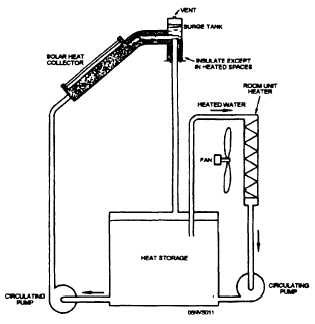is shown in figure 15-14. (See table 15-1 for advantages of air versus liquid.) The heat storage tank is replaced by a rock bed (nominally 1 to 3 inches in diameter). Rock provides desirable temperature stratification. Designs should emphasize the minimum pressure drop through the rock bed. The rocks can be stored in a bin, which should be insulated, or beneath the building if this is feasible. Heat collected by the collectors is blown through the rock bed from top to bottom. Heat is delivered from storage to the building by circulating air in the reverse direction, bottom to top. Note that in contrast to water storage, heat cannot be added to and removed from the rocks at the same time.
During heat collection, the rocks at the top of the bin attain a temperature almost equal to that of the incoming solar-heated air, while the air leaving storage is delivered to the collectors at the minimum temperature of the rocks. The conduction between the rocks is small; thus, with no air circulation, the rock bed remains stratified with the top of the rock bed warmer than the bottom. Also, limited conduction and convection in the rock bed significantly reduce heat loss from the rock bed.
Heat is drawn from storage by circulating air from the building directly through the rock bed from bottom to top. The air is delivered to the building at a temperature near the maximum temperature of the collectors. If additional heat is required, supplementary heat is added downstream from the storage unit. This system allows the rock bed to deliver useful heat until all of the rocks are at room temperature. A variation is a no-storage air heating system that circulates heated air when available. Performance is limited to daytime heating because of the lack of storage, but such systems are well suited to warehouses and factories with daytime operations. Domestic hot water is provided by pumping the water in the preheat tank through an air-to-water heat exchanger placed in the return air duct from the collectors. This is not efficient and is one of the disadvantages of the air system.
Heat Distribution for Liquid Types of Solar Systems
The temperature requirements of a hydronic heating system depend on the amount of heat exchanger surface. Most baseboard heaters have comparatively small surface areas, so they require higher temperatures, typically about 180F. If larger heat transfer areas are available, as in older or modified hot-water systems, temperatures of 120F maybe sufficient. Temperatures of 100F to 120F are adequate for the system that uses entire floors, walls, and ceilings as radiator surfaces.
During the winter, typical liquid types of solar systems are seldom operated at delivery temperatures above 150F. Clearly the use of

Figure 15-11. - Minimum heating system showing relationship of collector, storage, and room unit heater.
Continue Reading